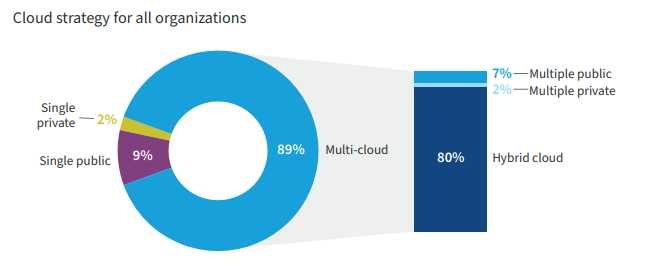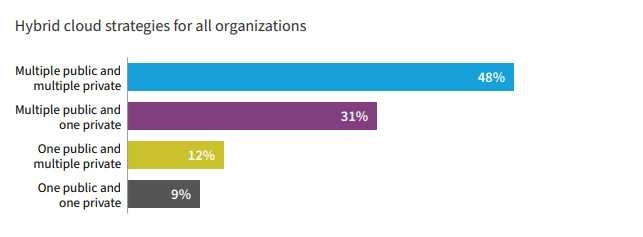
What is multicloud networking? Simply put, it’s the orchestration of cloud service delivery and the extension of cloud services from one enterprise data center to another. By leveraging multiple clouds, businesses can enjoy a host of benefits, including increased agility, improved performance and enhanced disaster recovery.
Multicloud networking defined
Multicloud networking is the practice of using cloud services from multiple, heterogeneous providers. This includes public cloud providers like AWS, Google Cloud Platform, or Microsoft Azure, as well as specialized platform-as-a-service, infrastructure-as-a-service or software-as-a-service providers.
SEE: Hiring Kit: Cloud Engineer (TechRepublic Premium)
Multicloud is not the same as hybrid cloud, which blends the use of private and public cloud environments. Rather, multicloud takes a mixed approach, using the best services from various providers to create a custom solution for an organization’s specific needs. This approach allows organizations to take advantage of the latest innovations from each vendor while avoiding vendor lock-in and ensuring maximum flexibility. Multicloud networking can be complex, but it provides a powerful way to build a custom, scalable and highly-available cloud infrastructure.
Organizations embrace multicloud
According to the Flexera 2022 State of the Cloud report that surveyed 753 respondents comprising global cloud decision-makers and users, 89% of respondents reported having a multicloud strategy. multicloud remains the de facto standard for enterprise cloud usage, with a clear majority of organizations using two or more clouds.
Figure A

In the Flexera survey, 79% of respondents said they use multiple public clouds, and 60% reported using more than one private cloud — an increase from the previous year. The most common architecture is a combination of different public and private clouds.
Figure B

Common types of multicloud implementations
Apps siloed on different clouds
Siloed apps are the most common type of multicloud implementation, where each application is run on a different cloud. This can be beneficial from a cost perspective, as you can choose the most cost-effective option for each app. However, it can also make management more difficult, as you need to maintain multiple console logins and configurations.
DR/Failover between clouds
Another popular option is DR/failover, where you have a primary cloud that runs your applications and a secondary cloud that kicks in if the primary goes down. This provides increased redundancy and uptime but can be more expensive to maintain.
Data integration between clouds
This involves creating a conduit between two or more clouds in order to allow data to flow between them. This can be done using an intermediary platform, such as an iPaaS, directly connecting the clouds using APIs, web services or ETL tools. Data integration can synchronize data between different cloud environments or move data from one cloud to another.
Workload mobility between clouds
Another common type of multicloud implementation is workload mobility between clouds. As its name suggests, workload mobility refers to the ability to move workloads — or, in other words, the computing tasks that make up an application — between different cloud environments.
This can be helpful for several reasons. For one, it gives organizations more flexibility in using cloud resources. For example, if an organization finds that it is using more resources on one cloud than it had originally anticipated, it can quickly and easily move some of its workloads to another cloud provider to avoid overage charges.
Additionally, workload mobility can help improve performance and availability by allowing organizations to shift resources to wherever they are needed most at any given time.
Finally, workload mobility can also help to reduce vendor lock-in levels. Because companies can switch vendors at any point without having to worry about losing access to their data or applications, they are free to choose the provider that best meets their needs — without being locked into a single provider.
Individual apps span public and private cloud
Worried about data security or compliance issues? You can keep your data on-premises and run your apps in the public cloud, or you can do the reverse and keep your apps on-premises while using the public cloud for storage. The key here is that each application spans both environments, public and private, to take advantage of the benefits of both.
Cloud bursting
Cloud bursting is a type of cloud computing in which an application that runs on a private cloud or on-premises infrastructure “bursts” to use resources from a public cloud when it needs additional capacity. Cloud bursting can be used to supplement the capacity of on-premises or private cloud data centers during peak demand, providing flexibility and scalability while minimizing costs.
One advantage of cloud bursting is that it can help to minimize downtime by providing resources from the public cloud when demand exceeds the capacity of the private cloud or data center. However, cloud bursting can also be complex to implement and manage, requiring careful planning to avoid performance issues. As a result, it is often used only by large organizations with the resources to manage a complex multicloud environment effectively.
Why multicloud networking is necessary
Autonomy
The paradox of cloud adoption is that vendors lock you into their infrastructure by deliberately making it complex and expensive to migrate. Multicloud networking is essential for avoiding vendor lock-in and maintaining autonomy over one’s infrastructure.
First, multicloud networking allows organizations to use multiple vendors for different workloads. This way, if one vendor raises prices or experiences an outage, businesses can simply switch to another provider without incurring significant costs.
Second, multicloud networking provides organizations with more control over their data. With multicloud, businesses can store data in different locations and choose which vendor has access to it. This allows businesses to keep sensitive data off of public clouds where it could be vulnerable to hackers.
Finally, multicloud networking allows organizations to customize their infrastructure to their specific needs. By using multiple vendors, businesses can select the tools and services that best fit their needs rather than being forced to use the one-size-fits-all approach of a single vendor.
Less disaster prone
By spreading your data and apps across multiple cloud environments, you’re less likely to experience a total shutdown if one cloud should fail. In addition, multicloud networking can help to improve performance and reduce costs by taking advantage of the unique capabilities of each platform.
Superior security
The cloud has become an essential part of modern business, but some organizations have been slow to adopt due to concerns about security and loss of control. Vendors have responded with private cloud solutions that offer more visibility and control, but these can be costly and complex to manage. A more promising solution is multicloud networking, which allows businesses to maintain a hybrid cloud environment that combines the best of both worlds: The security of a private cloud with the cost savings of a public cloud.
By leveraging the strengths of both environments, businesses can ensure that their mission-critical apps and data are always available and secure.
Low latency
Cloud-based applications are often used by businesses to improve customer experience or create new revenue streams. However, the performance of these apps can be hindered by latency, which is the time it takes for data to travel between the user and the app. To ensure optimal performance, businesses are turning to multicloud networking solutions that offer low latency and high throughput.
Data centers closer to end-users can serve requested data with far fewer server hops, which is critical for global companies that need to deliver data across country borders while still providing a consistent end-user experience.
Optimized ROI
Multicloud networking enables organizations to take advantage of the unique capabilities of each platform while still maintaining a consistent network infrastructure. It can help to optimize ROI in several ways.
First, it allows businesses to leverage the strengths of each platform, such as increased scalability or lower costs. Second, multicloud networking can help reduce downtime by providing failover capabilities in an outage. Finally, multicloud networks can provide greater flexibility and agility, allowing businesses to quickly and easily adapt to changing needs.
Multicloud networking is a promising solution for businesses that want to improve performance, reduce costs and increase security. By leveraging the strengths of each platform, businesses can create a customized infrastructure that meets their specific needs. In addition, multicloud networking can help to optimize ROI by reducing downtime and increasing flexibility.
